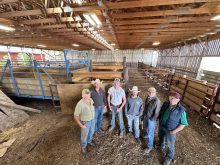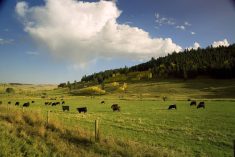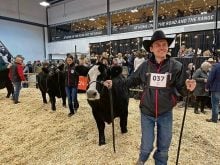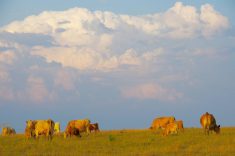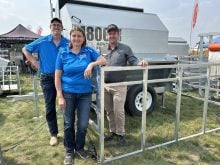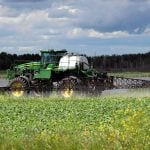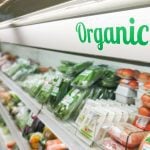Forage
Mountainview, a sainfoin with staying power
By Peg Strankman
Mountainview, a new sainfoin cultivar, developed by Dr. Surya Acharya through the Agriculture and Agri-Food Canada (AAFC) research station in Lethbridge appears to have met the challenge of persistence for this palatable forage. In field testing it has shown it can survive and prevent bloat in mixed stands with alfalfa.
“Up to this point sainfoin had been selected for biomass production and winter hardiness,” explains Alberta forage specialist Linda Hunt. “This resulted in the development of varieties that had excellent production when grown in a pure stand for hay or once-over fall grazing, but weren’t suitable for multi-cut hay or grazing systems. Forage growers found that although sainfoin was palatable, it just did not persist more than one or two growing seasons in mixed stands and so was not worth the high cost of seed.”
Read Also
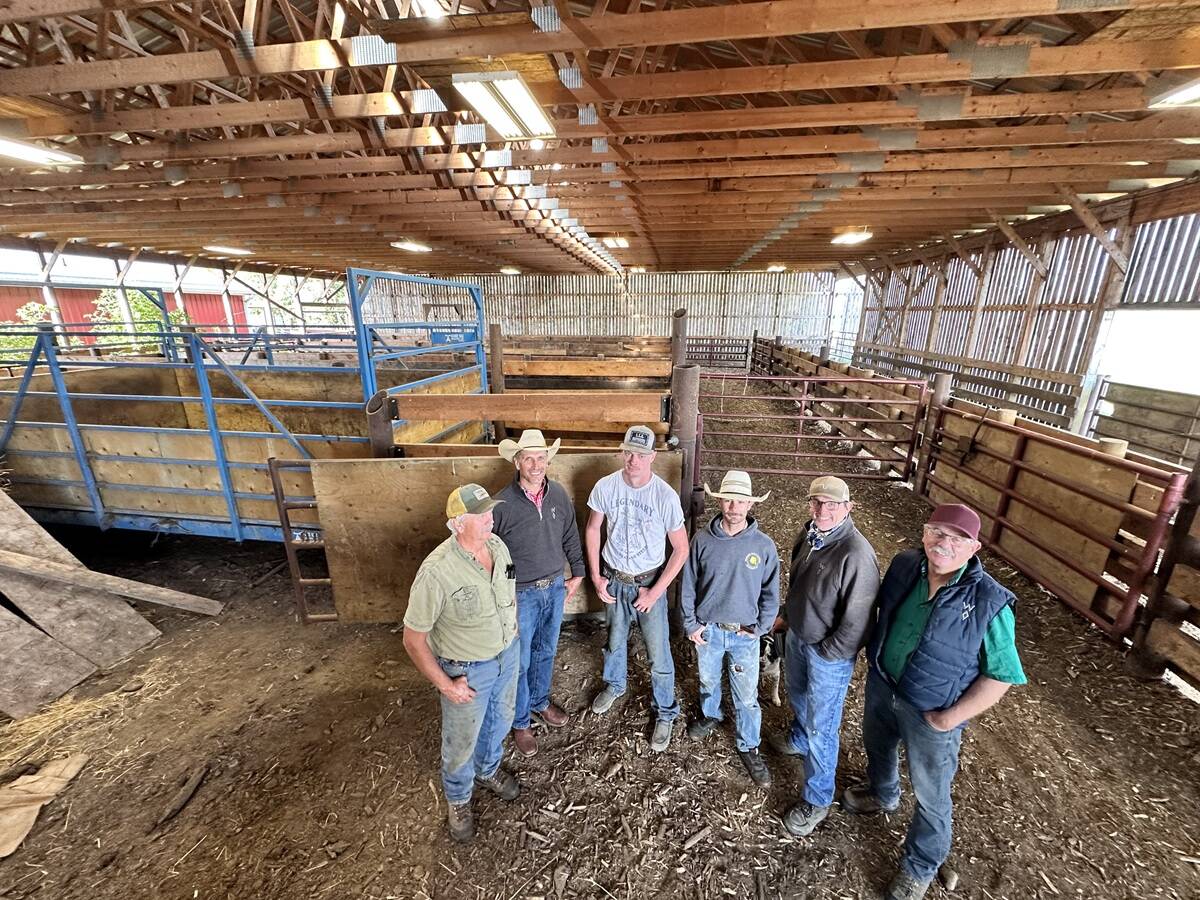
Farm families work together to graze cropland with cattle in the fall
These Alberta farm families have separate operations, but work together to manage their land
“AC Mountainview is a different kind of sainfoin and unique in North America,” says Hunt. “This new variety was selected from populations being grown with alfalfa under a multi-cut system. The resulting variety has excellent regrowth and the potential to persist in stands of alfalfa. The idea is that the tannins in the sainfoin, when seeded in the right proportion with the alfalfa, will buffer the bloat risk of the alfalfa and allow producers to safely graze a high-quality, highly productive forage stand. Early research in this intensive grazing system is showing promise.”
At least 15 per cent sainfoin on a dry matter basis in the sward seems to be enough to ensure no bloat occurs.
Foothills Forage and Grazing Association (FFGA) arranged a tour of some of the test fields in southern Alberta in August. First stop was at the AAFC research station in Lethbridge to get the latest information on the field trials from forage researchers, Drs. Alan Iwaasa and Eddie Sottie.
Trials at the AAFC Lethbridge and Semiarid Prairie Agricultural Research Centre (SPARC) at Swift Current indicate Mountainview has good stand survival under continuous grazing with low stocking rates. However, SPARC forage researcher Alan Iwaasa says the survival rate was not as good in rotational grazing trials with high stocking rates.
Based on these results Iwaasa suggests the Mountainview cultivar may have limitations in the dryland brown soil zone. It seems that to maintain a sainfoin stand under an intensive grazing system in the brown soil zone management needs to include delayed grazing or harvesting after seed pod formation
Sottie, a forage researcher at AAFC-SPARC, says the Mountainview sainfoin consistently showed higher mean total yearly dry matter yield over older varieties like Nova in pure and mixed stands in the plots maintained at Lethbridge and Saskatoon. “We also found average daily gain in alfalfa-sainfoin mixed pastures were similar to gains in pure alfalfa pastures,” he says.
For producers who would like to try the new sainfoin in their grazing rotation there are still challenges. Seed supply for Mountainview is not yet available. A hailstorm last year at the Lethbridge research station set seed collection back a year. Although a couple of seed companies do include sainfoin in some seed mixes these are likely a U.S. variety and may not persist under Canadian conditions.
It is expected there will be some seed for the new Mountainview cultivar available in 2015 with a more abundant supply ready for 2016. Producers should contact their local forage associations for the results of how well sainfoin performed in the local trials and to check on seed availability for next year.
Dr. Bill Newton who ranches at the south end of the Porcupine Hills west of Fort Macleod has plenty of experience with sainfoin. During the FFGA tour Newton showed two sainfoin pastures, one seeded 11 years ago and a second that was seeded prior to 1979. The key to sainfoin persistence in his experience is making sure the plants set seed at least every two to three years. “You have to be prepared to manage it,” he says. “As the pastures mature I probably have lost some production but given the ecosystem services like carbon retention and water infiltration I get back it’s more than worth it for me. I try not to come back in less than 60 days. It’s so palatable the cows will graze the same plant repeatedly and that weakens it.”
Gary Brown, the second grazier on the sainfoin tour says he likes the sainfoin for grazing but not for hay. He seeded his field to sainfoin and brome grass in 1997 seeding into barley stubble in poorer soil just southeast of the Pine Coulee reservoir. Brown grazes the sainfoin mix later in May, then letting it regrow and set seed. He usually puts cattle back in for a while after it has gone to seed.
Past experience from producers and forage researchers in establishing sainfoin in Alberta suggests it does well in well-drained, dry sites in soils that have neutral to alkaline pH. It does not like wet roots. Heavy trash cover should be avoided. It’s recommended the seed be placed within one to two centimetres of the soil surface.
Sainfoin has a large seed. There is just one seed in each seed pod so the seed is sold with the hull intact. It’s recommended it be seeded in the pod at a rate of 36-42 pure live seed/metre (nine to 13 seeds per foot of row). This is equivalent to six to 35 pounds per acre, depending upon how far apart the rows are spaced. Row width should not be more than 12 inches to keep appropriate sainfoin density in a mixed pasture stand. It is not recommended for seeding with a cover crop. Reduce the seeding rate by one-third in mixtures with grasses.
Because the sainfoin seed is so much larger than alfalfa mixed stands of the two, legumes have to be seeded in alternate rows in two passes or using two planter boxes with alternate runs blocked.
Sainfoin seed should be inoculated, however, no inoculant is currently registered for use in Canada. The fact that sainfoin-specific inoculant has a relatively short shelf life has been a barrier to obtaining CFIA registration. The Canadian Forage and Grassland Association is working to find a solution.
Nutrition
Vitamin E levels drop in stored feeds
Fresh, green forages supply adequate levels of vitamins to meet the needs of beef cattle, but that’s not so once it’s cut, says Alberta Agriculture beef and forage specialist Barry Yaremcio. Within days of cutting, the precursors for vitamins in hay start to oxidize. How fast this happens depends on moisture content of the bales and weather conditions.
Precursors are substances in feed that the animal converts to active forms of vitamins. The precursor for vitamin A, for example, is beta carotene. The sun’s ultraviolet rays convert the vitamin D precursor to active vitamin D.
Supplementing with the actual vitamins is recommended when feeding forage that has been baled for more than 90 days, Yaremcio says. Ensiling destroys vitamin precursors, so vitamins have to be added to silage-based rations.
Vitamin injections won’t sustain adequate vitamin levels through the winter and it’s important to check the label on injectables to find out if vitamin E is included at an effective level. Generally, vitamin A-D injectables contain only small amounts of vitamin E as a preservative. A nutrient must supply at least 10 per cent of the daily requirement to be listed on a label as an active ingredient.
The best way to supplement vitamins is to feed them. Unfortunately, most commercial mineral-vitamin products are not meeting vitamin E requirements, according to Yaremcio.
His advice is to consider boosting vitamin E by ordering custom mineral mixes or purchasing vitamin E separately and adding it to your commercial mix. Vitamin E is available from feed mills and some farm supply centres in 25-kilogram (kg) bags containing 50,000 international units (IU) per kg for roughly $125 per bag. It might seem pricey, he says, but the results of increasing vitamin E levels to support immune function and reproduction will be worth it.
The latest version of CowBytes (a ration balancing calculator with supporting information on feed requirements for beef cattle), includes higher vitamin E levels than the 2000 National Research Council guideline of a minimum 15 IU per kg of dry matter intake. Dry matter intake can be anywhere from one to three per cent of the animal’s body weight depending on hay quality and many other variables, whereas the CowBytes calculation is based on IU per head per day.
Research since 2000 has recommended 500 IU of vitamin E per head per day for lactating cows and heifers and 300 IU per head per day for all other classes of cattle. Cattle under stress, including newly weaned calves and those arriving at feedlots, should receive 400 to 1,000 IU per head per day for one to two weeks.
The increase to 300 IU for calves isn’t reflected in the CowBytes program. This can be updated by clicking on the modifications tab, changing the 100 value for vitamin E to 250, and then saving the change for future use.
You have to remember, he says, that weathering reduces overall hay quality. Even if minerals and vitamins test adequate, animals won’t get the full value if poor quality reduces daily feed intake.
If the feed was borderline for quality when tested in September and stacked outdoors, then it should be retested four weeks before the start of calving. There’s no need for a second feed test when hay is stored under a tarp or shed.
Retesting two-year-old bales is strongly recommended, he adds. Carry-over hay can be one to three per cent lower in protein, five to eight per cent lower in total digestible nutrient and five to 10 per cent lower in digestibility than current-year hay.
CowBytes is available for $50 from Alberta Agriculture by calling 780-427-0391, or search for “cowbytes” to see the program demo and order online. Yaremcio can be reached at 403-742-7926. Also see John McKinnon’s nutrition column and Ron Clarke’s vet advice column in Canadian Cattlemen’s February 2014, issue for more on vitamin supplementation.
Trade
Free trade creeps closer
Canada’s free trade files with South Korea and the European Union (EU) took some giant steps forward last month.
First Prime Minister Stephen Harper and South Korean President Park Geun-hye formally signed off on the final text of the Canada-Korea free trade agreement, three months after it was tabled in the House of Commons, and agreed to put the agreement into force “as quickly as possible.”
Before that can happen the enabling legislation and regulations must be approved by the Canadian Parliament and the Korean National Assembly.
The Canadian Cattlemen’s Association (CCA) noted the final text calls for a 40 per cent Korean tariff on fresh and frozen beef to be “fully eliminated in 15 equal annual steps” while an 18 per cent tariff on offals will end in 11 such steps — a faster pace than the rate of reduction for offals from the U.S.
Tariffs of two to eight per cent on beef fats and tallow are to be eliminated immediately on implementation.
Korea reopened to Canadian beef in 2012 — the same year Seoul’s free trade deal with the U.S. came into force. As a result, the U.S. has enjoyed an increasing tariff advantage flowing from its free trade agreement with South Korea.
In 2002, Korea was a $40-million market for Canadian beef and our fourth-largest export destination. In 2013, our export sales to Korea were down to $7.8 million.
The CCA’s director of government and international relations, John Masswohl, noted the deal calls for “an aggressive phase-out on (tariffs for) offals that get more value in Korea than they do here in North America.”
Just as the Korean deal started to fade from the news cycle Prime Minister Harper along with European Council president Herman Van Rompuy and European Commission president Jose Manuel Barroso released the negotiated text of the Canada-EU Comprehensive Economic and Trade Agreement (CETA)in Ottawa.
When this deal comes into force, which may not be until 2017, almost 94 per cent of EU agricultural tariff lines are to become duty free, including durum wheat (up to $190 per ton), other wheat (up to $122 per ton), and oils such as canola oil (3.2 to 9.6 per cent), the government said.
The Canada/EU deal also sets up a mechanism under which Canada and the EU will discuss and “attempt to prevent or resolve non-tariff barriers that may arise” on ag exports.
For Canada’s beef sector, CETA will eventually offer duty-free access for 64,950 tonnes per year. Of this, 50,000 tonnes — 35,000 tonnes of fresh/chilled beef and 15,000 tonnes of frozen beef — would be reserved for Canada.
In a release the Canadian Cattlemen’s Association (CCA) Canada said the 20 per cent duty on the existing 14,950-tonne “Hilton quota” shared with the U.S. will be reduced immediately to zero, and Canada will also still have access to the existing shared duty-free quota for high-quality grain-fed beef.
“Combined with the new access, there is a potential to reach more than 100,000 tonnes per year of duty-free access for Canadian beef,” the CCA said.
Live cattle, genetics and most beef offals and processed beef products will benefit from “immediate” unlimited duty-free access, the association added.
The ratification process can get underway on a Canada/European Union free trade deal now that negotiations are formally concluded.
CCA president Dave Solverson says cattlemen would like to see the same unanimous endorsement from all the provinces and territories that the agreement-in-principle received last fall. “The CCA urges the federal and provincial governments to move quickly to implement the agreement as soon as possible.”
The agreement has been hailed as a game changer for Canada’s beef industry, as the removal of long-standing barriers in this agreement, such as high tariffs, enables Canadian beef producers to benefit from the high-valued European beef market.
The CCA has been working on the CETA from the outset of negotiations in 2009, engaging with the Canadian negotiating team and conducting advocacy with key EU and Member State officials and industry representatives. CCA representatives attended numerous negotiating rounds in Brussels and Ottawa and met regularly with the Canadian negotiators of CETA to ensure they clearly understood the needs of Canada’s beef sector.
Seedstock
Lowlines make the cut
North Dakota State University’s Dickinson Research Extension Center has given the Lowline breed a permanent place for now in its beef evaluation program. The decision to establish a first-cross (F1) Lowline herd evolved from an earlier look at the potential of Lowline bulls as easy-calving sires to produce crossbred feeder cattle with performance and carcass quality suitable for today’s mainstream beef industry.
 From 2004 though 2007, the average birth weight of the 126 Lowline-sired calves from the conventional herd of Red and Black Angus females ranged from 64 to 75 pounds. In the feedyard, average daily gain each year ranged from 2.73 to 3.81 pounds, with 68 to 100 per cent of carcasses grading Choice or higher and 75 to 87 per cent being yield grade three and lower.
From 2004 though 2007, the average birth weight of the 126 Lowline-sired calves from the conventional herd of Red and Black Angus females ranged from 64 to 75 pounds. In the feedyard, average daily gain each year ranged from 2.73 to 3.81 pounds, with 68 to 100 per cent of carcasses grading Choice or higher and 75 to 87 per cent being yield grade three and lower.
Satisfied that Lowline-influence steers will meet the needs of today’s beef industry, the program discontinued use of Lowline bulls but retained the F1 Lowline heifers.
The researchers liked what they saw in an initial evaluation of the heifers’ performance, so the question expanded to how to make the most of Lowline genetics in a commercial cow herd.
A comparison of the 2010 F1 Lowline replacement heifers to replacement heifers from the conventional herd (in brackets) was: weaning weight 487 (574) pounds, hip height 41.1 (43.3) inches, frame score 3.75 (5.26), rib-eye area 5.31 (5.94) square inches; rib-eye per hundredweight 0.92 (0.82), fat depth 0.08 (0.25) inches, spring weight 552 (664) pounds.
In 2011, they followed cow size and calf weight through to weaning with the following results for F1 Lowlines and conventional females (in brackets): calf birth weight 68 (91) pounds, cow weight 999 (1,358) pounds, weaning weight 537 (585) pounds, cow weight at weaning 1,035 (1,287) pounds, calf weight as a percentage of cow weight at weaning 51.9 (46.2), acres per pair 10.1 (12.5); gain per acre 32.4 (23.6).
Kris Ringwall, the centre’s director of animal science, says Lowline-sired steer calves could be finished through traditional channels, while the half-blood heifers could go into a terminal Lowline cow herd to reduce cow size, reduce calving issues, and produce additional gain per acre.
The net result would be shaving 300 pounds off cow size, while retaining muscle mass to produce mainstream beef carcasses with more rib-eye per hundredweight, which translates into more muscle mass per pound of body weight.
The centre’s program will continue with both the conventional and F1 Lowline herds bred to Red and Black Angus and Limousin bulls. Some of the F1 Lowline females will be bred to Lowline bulls with the goal of establishing a foundation purebred Lowline herd.
Ringwell’s presentation is available at usa-lowline.org.



